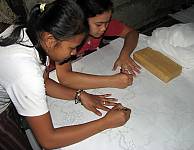
ation with the Batik Museum in Pekalongan Indonesian Batik is a traditional hand-crafted dye-resist textile rich in intangible cultural values, passed down for generations in Java and elsewhere since the early nineteenth century. The batik community noted the younger generation’s interest in batik was waning, and felt the need to increase efforts... Indonesia
11.COM : Examination of proposals to the Register of Best Safeguarding Practices
The Committee Takes note that Argentina has proposed the Randas of time, a safeguarding model of textile art at El Cercado (No. 01212) for selection and promotion by the Committee as a programme, project or activity best reflecting the principles and objectives of the Convention: The randa is a type of intricate, decorative craftwork mainly foun...2 December 2016
Addis Ababa
to demonstrate and exchange techniques during the workshop. International and national specialists in textile techniques and regional NGOs involved in promoting handicrafts were invited to attend the workshop and give training courses for young Miao/Hmong professionals. ,Regional Workshop on the Transmission of the Traditional Technique of Costume-...1 June 2000 - 1 June 2000
Kunming
Craftsmanship of Alençon needle lace-making
d the very long time that it takes to produce (seven hours per square centimetre). The pieces of openwork textile using the technique are used for decorative purposes in civil and religious life. The piece is made up of design elements held together by a finely stitched net. Its process comprises a number of successive stages: drawing and pricking... France
The Committee Takes note that Ghana has nominated Craftsmanship of traditional woven textile Kente (No. 02130) for inscription on the Representative List of the Intangible Cultural Heritage of Humanity: In Ghana, Kente is a fabric made of strips that are woven from silk, cotton or rayon using horizontal looms. The age, social status and gender of...6 December 2024
Asunción
unding nature and cosmos, which express people’s wishes and hopes. The practice involves selecting the textile and threads, drawing ornaments, creating needlepoint images and sewing clothes. In the past, the threads were prepared from cotton and silk fibres and coloured with natural paints made with plants and minerals: nowadays, Chakan dressmake...1 December 2018
Port Louis
Traditional knowledge is celebrated at the 2022 World Forum for Intangible Cultural Heritage
onal knowledge and sustainable development, such as: Andean cosmovision of the Kallawaya in Bolivia, Tais, traditional textile in Timor-Leste, Success story of promoting traditional foods and safeguarding traditional foodways in Kenya. This event contributes to the recognition of such indigenous practices, by giving them visibility and honori... international
20 September 2022
Yuki-tsumugi, silk fabric production technique
e Representative List could serve to heighten international awareness of the diversity of traditional textile techniques worldwide as evidence of human creativity;,Safeguarding measures - for instance, holding workshops and training programmes and organizing exhibitions - are underway with the participation of the community and authorities at the m... Japan
d the very long time that it takes to produce (seven hours per square centimetre). The pieces of openwork textile using the technique are used for decorative purposes in civil and religious life. The piece is made up of design elements held together by a finely stitched net. Its process comprises a number of successive stages: drawing and pricking...19 November 2010
Nairobi
Traditional art of Azerbaijani carpet weaving in the Republic of Azerbaijan
ijani carpet weaving in the Republic of Azerbaijan The Azerbaijani carpet is a traditional handmade textile of various sizes, with dense texture and a pile or pile-less surface, whose patterns are characteristic of Azerbaijan’s many carpet-making regions. Carpet making is a family tradition transferred orally and through practice. Men shear sheep... Azerbaijan







